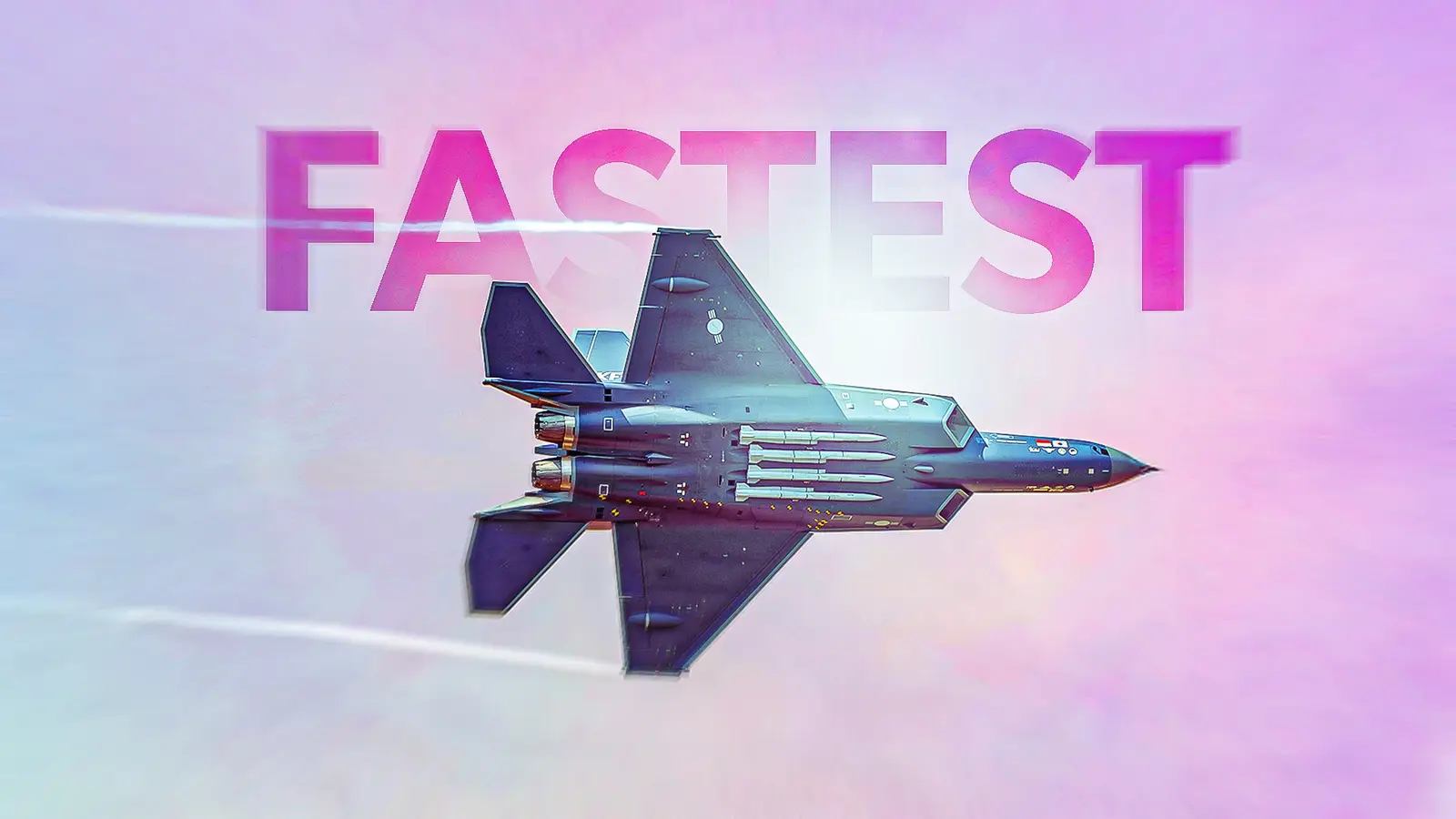Copyright Simple Flying

The legacy of American air power is a chronicle of iconic names and storied planes that made history for their engineering, innovation, and outstanding performance. When it comes to combat aviation, and specifically fighter jets, one of the most crucial metrics of a plane’s capability is its raw speed. In that arena, the United States proudly lays claim to many stunningly fast jets, but which was the fastest? To be clear, we are talking about fighters. No experimental prototypes or reconnaissance planes that occasionally had a missile strapped to the side. This list contains only warplanes that were made to fight - and win. So, without any further ado, let’s break it down by the numbers and stack up the fastest warbirds to ever wear the livery of the United States Armed Forces. 5 McDonnell Douglas F-4 Phantom Mach 2.23 The famous F-4 Phantom was one of America’s truly combat-effective supersonic fighters and one of the first common airframes shared by the US Air Force, Navy, and Marines. The Phantom broke speed, climb, and altitude records when it debuted in 1960 and just as quickly entered the fray in the Vietnam War. Aside from the captive F-4s flown by Iran, Greece still flies its F-4E Phantom IIs to this day, awaiting their succession by the Lockheed Martin F-35 Lightning II. Captain “Sully” Sullenberger, who famously landed his US Airways airliner on the Hudson River when he lost both engines from striking a flock of geese, was a Phantom pilot before he was a jetliner pilot. He described his experience flying the F-4 Phantom II fighter jet in the Air Force as being "like driving a Formula One racer on steroids." He has often cited his training in the military, including attending the US Air Force Academy, and his experience in the F-4 as giving him the skills to safely land the “Miracle on the Hudson.” The Phantom’s first sorties into harm’s way would be launched from the decks of US aircraft carriers in the South China Sea. The fighter's exceptional performance did lead to a strategic shortcoming in its early days, as the US chose to solely arm it with missiles. The brutal speed of the F-4 was a powerful tool for its pilots, but when North Vietnamese MiGs caught it in a turning fight, missiles and thrust proved lacking to win the day. Tragically, many were lost. The plane served until well into the 1990s despite its shortcomings in combat, not to say that Phantom drivers didn’t score their own victories over the years. Fourteen nations would fly the F-4, including close allies like Germany, the United Kingdom, and Israel. The design, engineering, and tactics that went into the Phantom informed future fighter development and lessons learned from the F-4 directly contributed to making the even more amazing planes we see today. 4 Lockheed Martin F-22 Raptor Mach 2.25 The fearsome Raptor is not only the apex predator of stealth fighters but also one of the only aircraft in the world capable of flying a supersonic cruise profile without afterburners, also known as “supercruise.” The indisputable champion of air power, the F-22 is not the fastest on this list, but its combination of radar-defeating stealth technology, advanced avionics, and “supermanueverability” combine to make it the last word in aerial combat. The Pratt & Whitney F119 thrust-vectoring, fifth-generation turbofan engine is the fire-breathing heart of this awesome flying machine, and it has two of them. The exhaust nozzles of the Raptor move in two dimensions to assist the huge stealth fighter in making physics-defying maneuvers. Once the most powerful jet engine in the world, it was only recently surpassed by the F135 turbofan that powers the F-35 family of fighters, but the Raptor has two to make up for that. The F-22 surpassed its predecessors in terms of technology and tactical capability, but it was never designed to be faster. The evolution of air warfare has simply placed a lower value on pure speed with the rise of new weapons, stealth technology, and other advanced systems. The supercruise capability and maneuverability of the Raptor are actually its most impressive performance features that make it as deadly as it is incredible to watch at an air show. 3 Grumman F-14 Tomcat Mach 2.34 Unmistakably, the most famous name on this list is Maverick’s ride. The star of Top Gun, Grumman’s beloved Tomcat, was a marvel of the Cold War era. The swing-wing fighter was designed to do battle with the fastest and fiercest airborne foes anywhere on the planet, and then catch a wire on the flight deck when it was done. Thankfully, it never had to meet its intended adversaries in hostile skies, but it remains the highest performance fighter jet in the history of the US Navy. Inspiring more than one generation of naval aviators, the Tomcat could go toe-to-toe with the Air Force’s air superiority fighter, the F-15 Eagle, and often come out on top. The F-14 and the Top Gun school were both products of lessons learned from the terrible losses suffered by Navy and Marine flyers in the skies over Vietnam. The Tomcat made no compromise in its design, ensuring that its pilots and weapons officers had every tool at their disposal to claim victory, and Top Gun taught them exactly how to do it. Perhaps outliving its natural service life thanks to the deep-running affection it had garnered from the naval aviation community, the F-14 was only finally retired because of its increasingly prohibitive cost to operate. As a world-class air superiority fighter, the mighty jet was a complex machine to keep in top shape while living at sea for months on end. Its successor, the Boeing F/A-18 Hornet, traded performance for technology and reliability at a lower operating price. As the sixth-generation F/A-XX is taking shape now, the Navy will soon have a new, true heir to the vacancy left on the flight deck by the Tomcat’s absence. 2 General Dynamics F-111 Aardvark Mach 2.5 Surpassing Mach 2.5 at high altitude, the swing-wing fighter-bomber was brutally fast despite its lower profile in the fighter lineup compared to “sexier” jets like the F-14 and F-15 that stole the spotlight. The F-111 was first built for the US Air Force amid the Vietnam War as a strike platform, but its success saw it serve in many other roles for five decades. The EF-111A Raven was a highly successful electronic warfare variant of the Aardvark converted by Grumman and even claimed the only aerial victory in the history of the F-111 family. During Operation Desert Storm, one EF-111A outmaneuvered an Iraqi Air Force Mirage F1 and caused its pilot to impact the ground in pursuit of the Raven. Zero coalition aircraft were ever lost to missile attacks while a Raven escorted them. The F-111 was retired by the USAF in 1998 due to the cost of maintenance and the rising importance of stealth in aerial warfare. The Royal Australian Air Force (RAAF), however, continued to fly the jets until 2010 when they were replaced by Boeing F/A-18F Super Hornets. The land down under was the only other operator of the F-111, and the Aardvark remains the fastest jet ever flown by the Australian military to this day. 1 Boeing F-15 Eagle Mach 2.5+ The iconic “Eagle” not only boasts a combat record of zero losses and over 100 air-to-air victories, but it remains the highest performance fighter in the USAF today. The Air Force still has a number of legacy F-15C/D models that are being phased out as the latest and greatest F-15EX “Eagle II” variants are delivered. The F-15E “Strike Eagle,” introduced in 1989, however, is sticking around to complement the F-15EX for years to come. In early 2024, Boeing even stated that the Eagle II reached close to Mach 3.0 in testing, as Aviationweek reported. The F-15EX is likely to stay the speed king of the USAF even after the F-47 debuts with its proposed top speed around Mach 2. The legendary air superiority fighter was one of the USAF’s most intensive Cold War development projects and yielded a plane (especially the prototype “Streak Eagle”) that shattered records when it debuted in 1972. The future air force fighter strategy envisions a battlefield where the Eagles, with their huge ordnance payloads and high performance, are heavy hitters that back up the newer “exquisite” stealth fighters. On the battlefield of tomorrow, the sixth-generation F-47 will be the tip of the spear, with the fifth-generation F-22s and F-35s with “missile truck” F-15s zooming in to hit targets that the stealth jets pick out for them. The F-47 will not replace the F-15 directly in terms of performance or tactical role, but rather move into a completely new space in air warfare strategy. The optionally manned fighter will control Collaborative Combat Aircraft (CCA), or “Loyal Wingman” drones, while it functions as a deep-penetrating intelligence, surveillance, and reconnaissance (ISR) node behind enemy lines. The F-47, like the F-22 before it, with its revolutionary variable cycle engines (VCE) will trade top speed for fuel efficiency and maneuverability, and feature revolutionary new stealth enhancements. Thus, the mighty Eagle will continue to streak across the skies for decades into the future as the unrivaled king of speed.



